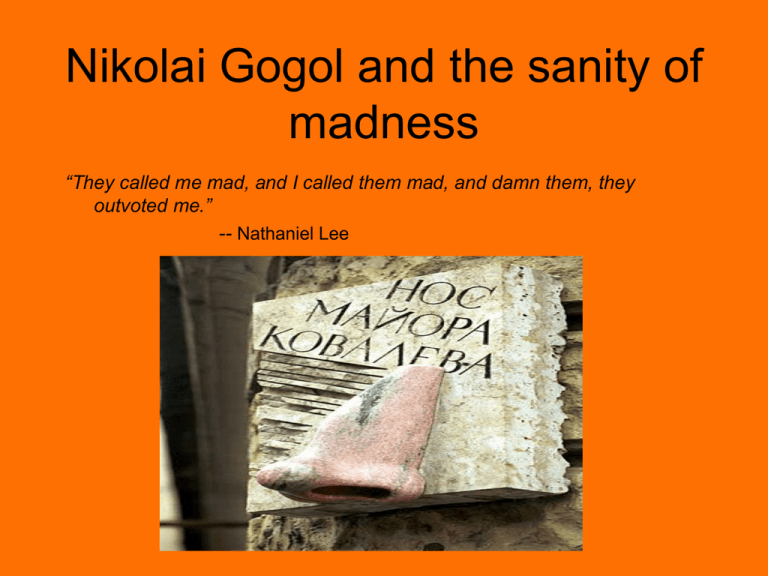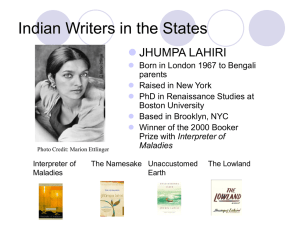PowerPoint Presentation - Nikolai Gogol and the sanity of madness
advertisement

Nikolai Gogol and the sanity of madness “They called me mad, and I called them mad, and damn them, they outvoted me.” -- Nathaniel Lee The rise of the pathography Romanticism fostered interest in individual lives and interior lives Psychiatrists claimed expert insight into pathologies of artists New triadic model proposed by Moebius: normal, abnormal, and somewhere in between Importance of literature in Russia Gogol’s Pathology: The two Gogols • • • • • Gogol pronounced mentally ill by the critic Vissarion Belinsky for his Selected Passages from Letters to Friends (1846) First Gogol: ingenious satirical writer, “realist” critical of Imperial Russian society Second Gogol: reactionary author of Selected Passages; proponent of autocracy, ignorance, knout; religious fanatic Insane or merely odd? “Diary of a Madman” is a satire of Petersburg society, satire “mirror held up to society,” but also a mirror of Gogol’s pathology Nikolai Gogol, 1809-1852 “artist-monk, Christian-satirist, ascetic and humorist, martyr of the exalted ideal and the unsolved riddle” • • • • Born into family of small Ukrainian landowners Capitalized upon provincial background, identity of country bumpkin Series of appointments as minor civil servant, adjunct professor of universal history at St. Petersburg University Early folk stories of Ukrainian countryside (1832), later sharply satirical Petersburg stories and plays “Inspector General,” most famous novel Dead Souls (1842) Questions for Discussion • Poprishchin’s (the madman) diary allows us intimate access to his perception of reality and his consciousness. What does Poprishchin notice and why? What is important to him, and how is it connected with his mental illness? • Consider one of Gogol’s most ingenious literary devices: the correspondence of Medji to Fidele. What is Gogol able to accomplish using this device? Gogol/Poprishchin: mirrored madness • • • • In “Diary of Madman” two Poprischchin’s: Poprishchin, titular counsellor, trivial, snobbish, envious, fixated on hierarchy, and King of Spain, who disdains everything Poprishchin values, (sees women as devil) rejects world, Christ figure Similarities to Skoptsy Gogol uses device of estrangement (perspective of madman, dogs) to show us “shocking morass of trivial things in which man’s life was entangled” Diagnosing social malaise peculiar to St. Petersburg, but Gogol/Poprishchin: mirrored madness • • • • In “Diary of Madman” two Poprischchin’s: Poprishchin, titular counsellor, trivial, snobbish, envious, fixated on hierarchy, and King of Spain, who disdains everything Poprishchin values, (sees women as devil) rejects world, Christ figure Similarities to Skoptsy Gogol uses device of estrangement (perspective of madman, dogs) to show us “shocking morass of trivial things in which man’s life was entangled” Diagnosing social malaise peculiar to St. Petersburg, but also human sinfulness











